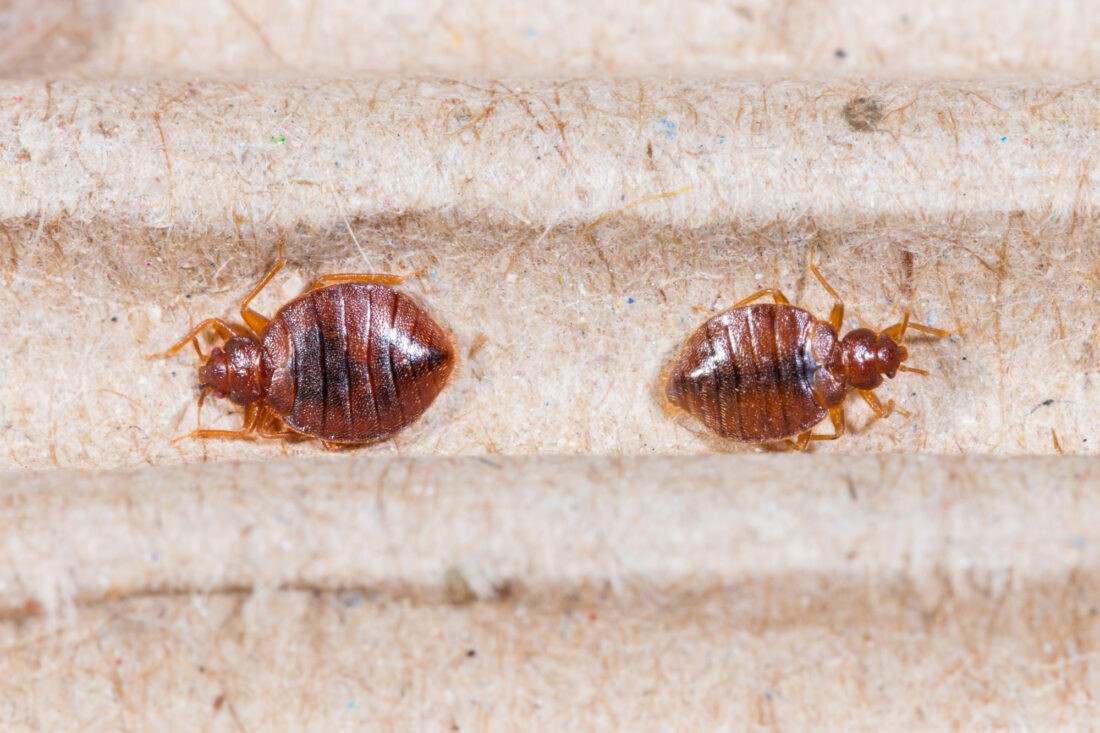Insect IDs: How to Identify Bugs in Oregon (Quickly!)

There are more than 500 different kinds of insects and bugs in Oregon. Each type, in turn, can have thousands of different species and genera.
However, just because they look “creepy” doesn’t mean they’re already harmful or dangerous. Still, you should learn how to identify bugs and insects, as some of them do have health effects. Others can also cause severe property damage.
We’ve listed some of the common household bugs in Oregon, so be sure to use this post as your bug identifier guide!
Table of Contents
Bed Bugs
In Oregon, bed bugs are everywhere, but it’s especially problematic in Portland. Being the capital of the state, the City of Roses has among the worst infestations in the entire US. So much so that it’s become the 50th most infected city throughout the country.
How These Bugs Affect You
Bed bugs have mouthparts that they use to pierce the skin of their “host.” They then use their elongated beak to withdraw blood and can feed between three and 10 minutes. As they do this, they also inject a substance into the skin that helps keep the blood from coagulating.
This is the secretion that can cause itchiness, swelling, and redness of the skin. Excessive scratching can then cause bruises, which, in turn, can become infected.
For the longest time, experts believed that bed bugs don’t directly transmit diseases. However, recent studies found that they carry at least 45 different pathogens.
One of these pathogens is the parasite called Trypanosoma cruzi. This is the same pathogen that the “kissing” bug transmits. It causes Chagas disease, a prevalent and also deadly disease throughout America.
What The Bugs Look Like
Adult bed bugs are tiny insects that can grow between 3/16 to 1/14 inch long (somewhat like an apple seed). Their elongated bodies can take on a reddish-brown or brown color.
Bed bugs that haven’t fed yet have an oval-shaped body. After feeding, however, they swell and become balloon-like. Well-fed bed bugs also take on a more reddish appearance.
How to Get Rid of Them
Bed bugs have developed resistance to various insecticides, such as neonicotinoids. As such, those bug sprays you use for other pests are unlikely to work on them.
According to this blog post, though, heat treatment is still an effective way to get rid of bed bugs in Oregon homes. One reason is that extreme heat can kill not only the adults but also their eggs and larvae.
Red Imported Fire Ants
The red imported fire ant (RIFA) originated from South America. That makes these ants a type of invasive species. They’re more than just intrusive, though; they can also cause severe property destruction.
What’s more, their stings can be excruciating and cause severe skin swelling.
How These Bugs Affect You
When these ants sting, they lock onto their victims using their mandibles. They inject venom through their stinger, which they have shown to do for seven up to eight times.
In some people, massive local skin reactions can occur, with some measuring up to 4 inches. The stung portion can also feel like it’s “burning,” hence the term “fire” in the name of these ants.
Fire ants can also establish humongous colonies. This is how they can cause significant property destruction. In 2003, for instance, the damage they caused in telecoms equipment cost the US $640 million.
What The Bugs Look Like
Red imported fire ants are reddish-brown, reddish-black, or bright. Note, however, that there’s also a black imported fire ant. According to the Oregon Government, though, RIFA is more likely to invade the state.
Red imported fire ants have bodies that can run up to a quarter of an inch long. Aside from mandibles, they also have stingers that protrude from their abdomen.
How to Get Rid of Them
Once established, RIFA colonies can be extremely difficult to control with DIY tricks. You’d have to get rid of all the mounds they’ve built at the same time. If you miss even just one of these nests, you’re looking at continued invasion.
If you think that you have a RIFA infestation, you should ring up your local pest control company. Getting rid of these ants may already require the use of regulated chemicals.
Brown Marmorated Stink Bugs
Oregon is home to at least 50 different types of stink bugs. There’s the green stink bug, tuxedo bug, and the red-shouldered stink bug, to name a few. Many of these critters, however, only classify as minor agricultural and household pests.
The brown marmorated stink bug (BMSB) is on a whole different class, though. It’s a severe invasive pest, injuring up to 100% of sweet cornfields in the US. They also love to feed on and destroy pepper, eggplant, and tomato crops.
How These Bugs Affect You
Brown marmorated stink bugs can invade your property and cause severe garden damage. They can also enter your home itself and congregate on your windows. Disturbing them will make your home smell really bad.
What The Bugs Look Like
Brown marmorated stink bugs have a brown body shaped like a shield. Their bodies are also hard, marked with countless white or yellowish spots. The adults can grow up to three-quarters of an inch long.
How to Get Rid of Them
Vacuuming can help control the indoor BMSB populations. Prepare yourself, though, as this method will make your vacuum cleaner stink for a long time.
That’s why you’d want to prevent these stinkers from entering your home in the first place. Installing mesh screens on all entry points of your Oregon home is one way to do that. You can also use wrap-around door sweeps to seal the gaps under your door.
Green Stink Bugs
Aside from the BMSB, green stink bugs are also among the most prevalent stink bugs in the Beaver State. They also cause agricultural damage, but not to the extent of BMSB. However, they can still invade your garden and even your home, stinking up things wherever they go.
How These Bugs Affect You
Green stink bugs will attack fruit-bearing trees growing on your Oregon property. They prefer developing fruits, in which they can leave injuries called “catfacing.” These are distortions and visible sunken areas on the outside of the fruits.
Green stink bugs can also enter your home and make it smell bad. As with all other stink bugs, they do this when they feel threatened.
What The Bugs Look Like
These bugs have bright green, shield-shaped bodies. Their abdomen features distinctive black marks along the sides. They have dark-colored antennae split up by lighter-colored bands.
Baby green stink bugs also have bright green bodies, although they come with more black marks. In very young nymphs, the protonum (plate-like structure below the head) is orange.
How to Get Rid of Them
Green stink bugs usually find their way inside homes by accident. If you find one or two of them in one of your rooms, try your best to lead them outside without swatting them. This way, you won’t have to deal with the foul smells they emit.
If there’s a large infestation, though, it’s best to contact local pest exterminators. This is especially important if you’re growing fruit trees.
Western Black-Legged Ticks
There are at least 20 species of hard ticks found in Oregon, but only four bite humans and animals. The most dangerous of these four is the western black-legged tick. That’s because it’s a carrier of Borrelia bacteria, which causes Lyme disease.
How These Bugs Affect You
The western black-legged tick can pass on the bacteria if allowed to remain on the skin for 36 to 48 hours. If this happens, the symptoms of Lyme disease can occur within three days from the infection. Some of the common signs include headaches, fever, as well as achy muscles and joints.
Do note that Oregon also has the Rocky Mountain wood and American dog tick, which can also cause diseases. Both can transmit the Rocky Mountain spotted fever. The symptoms are similar to Lyme disease, but the fever may also induce vomiting.
What The Bugs Look Like
An adult western black-legged tick is super small, about a tenth of an inch or less. They have a reddish-brown body, with the inner section being mostly brown. That makes them look pretty much like the deer tick, although they are a little more oval.
The Rocky Mountain Wood tick looks a lot like the American dog tick. The former, however, has a bright red body that resembles a teardrop.
The American dog tick is also bright red but has numerous black markings. It also has a whitish or yellowish section right below the head.
How to Get Rid of Them
All types of ticks cling to their host by using their mandibles, which they then burrow into the skin. If you find one of these bugs on you or your pet, use a pair of fine-tipped tweezers to take them off. Avoid jerking the tweezers, as this can make the mouthparts break off and remain buried in the skin.
Identify Bugs So You Can Use Proper Pest Control Techniques
There you have it, your guide on how to identify bugs and insects that are common in Oregon. Knowing how these critters look like can help you figure out if they’re friends or foes. This, in turn, can help you determine if it’s time to ring up your pest control specialists.
Ready for more home, health, and lifestyle guides like this? Then please feel free to check out our many other posts!









